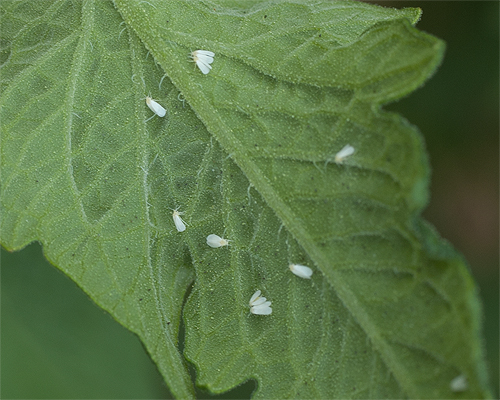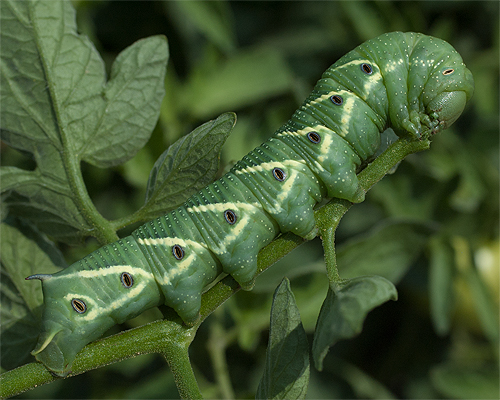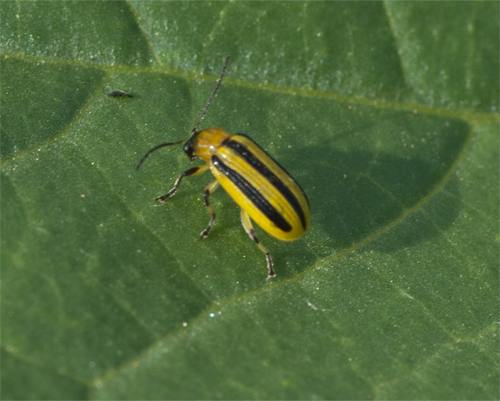
Fact Sheet FS1123
Insect Pest Management
Home vegetable gardeners will find more than two dozen major insect and mite pests that attack various vegetable crops and damage them by feeding directly on the foliage and fruit or by transmitting plant diseases. Some insect pests are serious problems every year, while others rarely appear in the garden. There are also many insects which are beneficial and, in several instances, essential to vegetable production in the home garden. Rutgers NJAES Fact Sheet FS295, "Beneficial Insects of the Home Garden," may be of help in identification of these beneficial organisms.
Frequent monitoring of the garden to detect problems at an early stage will allow you to prevent or reduce insect damage. However, for effective monitoring, the homeowner must know where and when to look for insect pests and be able to identify those that are found. Without proper identification, pest management is impossible.
Keys to Effective Management
- Thoroughly inspect plants at regular and frequent intervals to monitor any potential pest buildup. It is suggested to scout the garden at least twice weekly. Inspect plants from the bud to the soil, including both upper and lower leaf surfaces.
- Rotate the garden plot as often as possible. If the same plot is used more than one season, rotate the crops within the garden. Garden rotation is highly effective in reducing soil insect and disease problems.
- Plow or turn the soil well in advance of planting. The garden should be well plowed and free of weeds, grass, etc., at least 30 days before planting.
- Transplants should be purchased from a reputable dealer and should be free of insect pests and disease at time of planting.
- A healthy plant is often able to outgrow insect and disease attack. Use proper fertility and watering programs to maintain plant health and vigor.
- Learn to identify garden pests and beneficial organisms and consider chemicals only when a pest problem exists. Seek alternatives to chemical insecticides when possible.
- Harvest fruit, seed, pods, etc., as soon as they are ripe. Allowing overripe fruit to remain on the plants often invites additional pest problems.
- Once a plant is no longer productive, destroy it, plow it under, or remove it from the garden. DO NOT just pull it up and leave it in the garden area.
- If you use garden vegetable plants in any form to add to a mulch bed or compost bin, ensure that the material does not harbor insects, disease organisms or nematodes that will easily survive organic decomposition and cause future problems if that mulch is used in the garden.
| Insect Pest | Fact Sheet # | Synthetic Pesticide Control | Organic Pesticide Control | Cultural Control |
|---|---|---|---|---|
| Asparagus beetle | FS221 | Carbaryl, malathion | Neem, pyrethrin | Hand picking |
| Aphids | FS230, 248 | Malathion, pyrethroids | Beauvaria bassiana, canola oil, neem, pyrethrin | Row covers, high pressure water wash |
| Beetles | FS242, 222, 292, 241, 242, 249, 243 | Pyrethroids | Beauvaria bassiana, B. tenebrionis, pyrethrins, spinosad | Hand picking (wear gloves) |
| Cabbage looper | FS231 | Carbaryl, malathion, pyrethroids | B. thuringiensis, neem, spinosad, pyrethrin | Row covers, early planting, hand picking |
| Carrot weevil | FS250 | Pyrethroids | None | None |
| Caterpillers (corn borer, celeryworm, armyworm, melon worms, earworms, cabbage worms) see also hornworms, cabbage looper, cabbage webworms | FS284, 286, 238, 232, 285, 239, 281, 288, 282, 283, 287 | Carbaryl, malathion, pyrethroids | B. thuringiensis, neem, pyrethrin, spinosad | Netting, row covers, hand picking |
| Colorado potato beetle | FS224 | Pyrethroids | Beauvaria bassiana, B. tenebrionis, pyrethrins, spinosad | Row covers, hand picking all stages |
| Cabbage webworm | FS289 | Carbaryl, malathion, pyrethroids | B. thuringiensis, neem, pyrethrin, spinosad | Hand picking |
| Cucumber beetles | FS225 | Carbaryl, malathion, pyrethroids | Beauvaria bassiana, neem, pyrethrins | Row covers, hand picking |
| Cutworms | FS283 | Carbaryl, pyrethroids | Beneficial nematodes | Barriers |
| Flea beetles | FS233 | Carbaryl, pyrethroids, hot pepper wax | Beauvaria bassiana, insecticide soap, neem, pyrethrins | Row covers |
| Hornworms | FS226 | Carbaryl, malathion, pyrethroids | B. thuringiensis, neem, pyrethrin, spinosad | Hand picking larvae |
| Leafhoppers, fleahoppers | FS237, 236 | Malathion, carbaryl pyrethroids | Canola oil, pyrethrins | Row covers |
| Leaf miners | FS276 | Pyrethroids | Spinosad | Row covers |
| Mexican bean beetle | FS227 | Carbaryl, malathion, pyrethroids | Beauvaria bassiana, neem, pyrethrins | Hand picking all stages |
| Onion maggot, seedcorn maggot, cabbage maggot | FS278, 280, 277 | None available | None | Row covers |
| Pepper maggot | FS279 | Pyrethroids | None | None |
| Spider mites | FS235 | Malathion | Canola oil, insecticidal soap, pyrethrins | Water spray |
| Squash bugs | FS228, 246 | Carbaryl, pyrethroids | Neem | Hand picking all stages |
| Stink bugs, plant bugs | FS245, 244, 247 | Carbaryl, pyrethroids, refined horticulture oil | None | Hand picking bugs and eggs, row covers |
| Squash vine borer | FS229 | Carbaryl, pyrethroids | Spinosad | Cut borer out of stem |
| Thrips | FS291 | Malathion, pyrethroids | Insecticidal soap, pyrethrin, spinosad | High pressure water spray |
| Whiteflies | FS240 | Malathion, pyrethroids | Insecticide soap, canola oil, pyrethrins | Row covers |
| Common Name | Trade Names | Insecticide Class |
|---|---|---|
| Bacillus thuringiensis kurstaki | Thuricide, Dipel, Safer Caterpiller Killer | Bacterial |
| Bacillus thuringiensis tenebrionis | Novodor | Bacterial |
| Beauvaria bassiana | BotaniGard | Fungus |
| Carbaryl | Sevin, Ortho BugGeta Plus, Garden Tech | Carbamate |
| Hot pepper wax | Hot Pepper Wax, Bonide Hot Pepper Wax | Botanical |
| Insecticidal soap | Concern Multi-Purpose Concentrate, Concern Tomato and Vegetable Insect Killer, Safer 3-in-1, NATRIA Insecticidal Soap | Potassium salts/fatty acids |
| Malathion | Gordon's Malathion, Spectracide Malathion | Organo-phosphate |
| Neem | Tomato 3-in-1, Concern Multipurpose, Neem Ready to Use | Botanical |
| Petroleum oil | All Seasons Hort Spray, Bonide All Seasons | Hydrocarbons |
| Plant oils | Ecosmart Organic Flower and Vegetable, Ecosense, Garlic MiteX, Organocide, NATRIA Multi-Insect Control | Botanical |
| Pyrethrins | Garden Guard, Spectracide Garden Insect Killer, Bonide Garden Dust, Yard and Garden Insect Killer, NATRIA Insect, Disease and Mite Control | Botanical |
| Pyrethroids | Bayer PowerForce Multi-Insect Killer, Eight Garden & Home, Ortho, TOTAL Pest Control, Bug-No-More, Ortho Bug-B-Gon, Ortho MAX, Spectracide All Vegetables, Spectracide 3X Permethrin | Synthetic pyrethroid; pyrethroids include esfenvalerate, cyfluthrin, permethrin, gamma-cyhalothrin, bifenthrin |
| Spinosad | Jack's Deadbug Brew, Colorado Potato Beetle Beater | Fermentation by-product |
Pesticide products and formulations may change. Always follow label instructions. Check label for: number of applications allowed per season, interval between sprays, and the number of days between last spray and harvest.
Photo credits: Peter Nitzsche (l-r) whitefly, parsleyworm, cucumber beetle.
Mention or display of a trademark, proprietary product, or firm in text or figures does not constitute an endorsement by Rutgers Cooperative Extension and does not imply approval to the exclusion of other suitable products or firms.
March 2024
Copyright © 2024 Rutgers, The State University of New Jersey. All rights reserved.
For more information: njaes.rutgers.edu.
Cooperating Agencies: Rutgers, The State University of New Jersey, U.S. Department of Agriculture, and Boards of County Commissioners. Rutgers Cooperative Extension, a unit of the Rutgers New Jersey Agricultural Experiment Station, is an equal opportunity program provider and employer.



